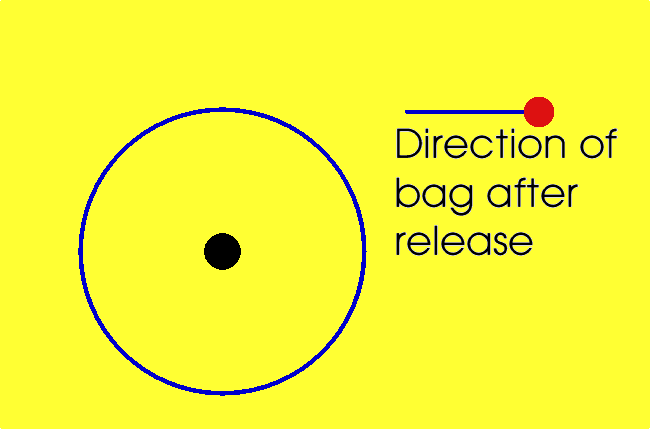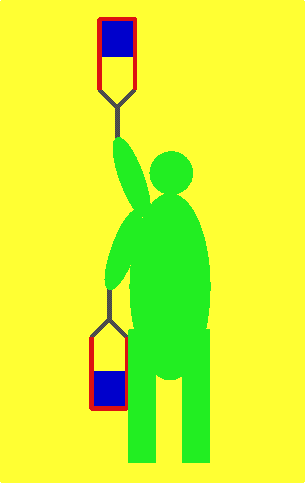Almost everything that Sam and his friends see moving, on the Earth or in the sky, is obeying Sir Isaac Newton’s Theory of Gravity and Laws of Motion.
The Theory of Gravity says that everything in the whole Universe is attracting everything else, with a force which depends upon their mass and the distance between them, and by everything I do mean everything, even you and Sam! But fortunately neither of you are very big and you are not very close to each other so neither of you notice the (purely gravitational!) attraction you have for each other. But the Earth is very big and you are very close to it so you do notice the attraction between you and it - it is called your weight!If you are about Sam’s age you probably have a mass of somewhere between 30 and 50 kg. The Moon is much smaller than the Earth so Moon gravity is much less than Earth gravity. If you go to the Moon you do not suddenly get so thin that none of your clothes fit, it is your weight (that is, the force of gravity on you) that has changed not your mass. On the surface of the Earth many people use mass and weight to mean the same thing but you must not do this anywhere else.
The Earth and the Sun may be millions of kilometres away from each other but the Sun is very big indeed so there is a very big gravitational force between them.
Newton’s Second Law of Motion says that if something is not moving we need a force to make it move, and if it is moving we need a force to make it move faster or more slowly or in a different direction. Sam has never played golf but he knows that the ball does not move until you hit it, but he has played beach tennis and knows that you need to hit the ball hard to return it (make it go back to the other end, that is, make it move in a totally different direction).
Sam realises that this means that if something is moving in a circle we need a force to keep it moving in a circle. One day he stuffs some old T-shirts into an old pillow case and makes them into a soft bundle on the end of a rope. He and his friends go onto the beach - they take a plastic bucket with their lunch in it as well as the rope and the bundle. On the beach they start swinging the bundle round in a circle. They can feel a force in the rope, the faster they swing it the bigger the force, it can be several times the weight of the bundle.We sometimes call this force the centrifugal force, from the Latin for fleeing from the centre, but if we let go of the rope this is not actually what happens, the bundle goes on in a straight line not straight outwards from the centre.

They do the same with the bucket filled with sea water - but stand well clear: if it hits you a bucket of water will hurt you much more than a bundle of clothes and make you very wet.
Adults (if you have not done this before it is best to practise beforehand wearing swimmers) can sometimes make the bucket go right over their heads without the water falling out. Children cannot often do this, they have to use a shorter rope so they must make the bucket go faster.

We can also feel a force when we go round a bend in a road too quickly: we may feel we are being thrown out of the car, but in fact there is no force trying to throw us out, what we feel is the force of the car on us trying to make us stay in the car rather than continue in a straight line. The tighter the curve and the faster we go round it the bigger the force needed to keep us in the car.
We often compare the forces acting on our body with the normal force of gravity on our bodies when we are on the surface of the Earth - this is 1 g (g for gravity not grams!). On a roller coaster, at the bottom of each loop we experience a force of more than 1 g, so there is a force pushing us down harder into our seat, as we go over the top of each loop we experience a force of less than 1 g, so we might be lifted out of our seat if we are not strapped in.
If you watch motor racing on tv you may sometimes see the g-force meter on the instrument panel: try watching it on a high-speed curve!
You can find out for yourself what would happen if you do not wear a seat belt in a car by using your Mum’s food blender without putting the lid on - but ask first. On a spin dryer the water is thrown out through the holes in the drum, but the clothes are too big to go through the holes so they stay inside.
The Earth is going round the Sun, so there must be a force acting on it to stop it from flying off in a straight line into space: this force is the gravitational force between the Earth and the Sun - the two exactly balance! And the same for all the other planets.
This is also the reason why the Moon and television satellites and GPS satellites and the International Space Station go round the Earth. But remember that when we are calculating their orbits we must not forget that they are also being affected by the Sun’s gravity as well as the Earth’s.
The ISS stays in its orbit round the Earth because the force needed to keep it from flying off in a straight line into outer space is exactly equal to the force of gravity between it and the Earth. And what is true of the ISS is also true of everything inside it, even you. If you are holding a jug of water and let go of it it will stay in the same orbit, if you turn the jug upside down you will not change the orbit of the water inside it: you and everything inside or even outside the ISS are weightless - true zero g! But remember your mass has not changed even though the bathroom scales are floating around inside the ISS just like you. If you accidently let go of your Hasselblad camera (value more than ten thousand pounds) while you are working outside the ISS - and this really has happened - it will stay in orbit long after you have returned to the Earth.
Under zero g conditions everything will just tumble around, but if an object is spinning on its axis it will stay spinning on the same axis as it moves around. Here is a video of a gyroscope in the ISS.
Giroscopes make wonderful toys but they are also very important in science and engineering. The Earth is spinning on its axis and this is what keeps it in the correct position as it circles round the Sun. This is more fully described in the Page on Precession.
When an aircraft pulls out of a dive it experiences a g-force of more than one, how much more depends upon how fast it is flying and how quickly it is pulling out. If the g-force is high the blood may go to your feet and you might black out as your brain is starved of blood: pilots of high performance military aircraft wear special g-suits to prevent this. If the aircraft is going over the top of a loop (a bunt) the g-force will be less than 1, it could even be zero or negative. Negative g-force can lead to red-out where blood goes to your brain, and this is very dangerous. Pilots of military aircraft get round this problem by turning the aircraft over and flying upside down so that they experience positive rather than negative g - you might have noticed this when high-performance aircraft give displays at Air Shows.
If you fly in a much more ordinary aeroplane in a very carefully controlled trajectory at a very carefully controlled speed you may be able to achieve several minutes of zero g. Stephen Hawking would never have been allowed to go to the ISS but in 2007 he did experience zero g for four minutes in an aeroplane - a web search on Stephen Hawking + zero g will give you some nice videos.
© Barry Gray October 2022